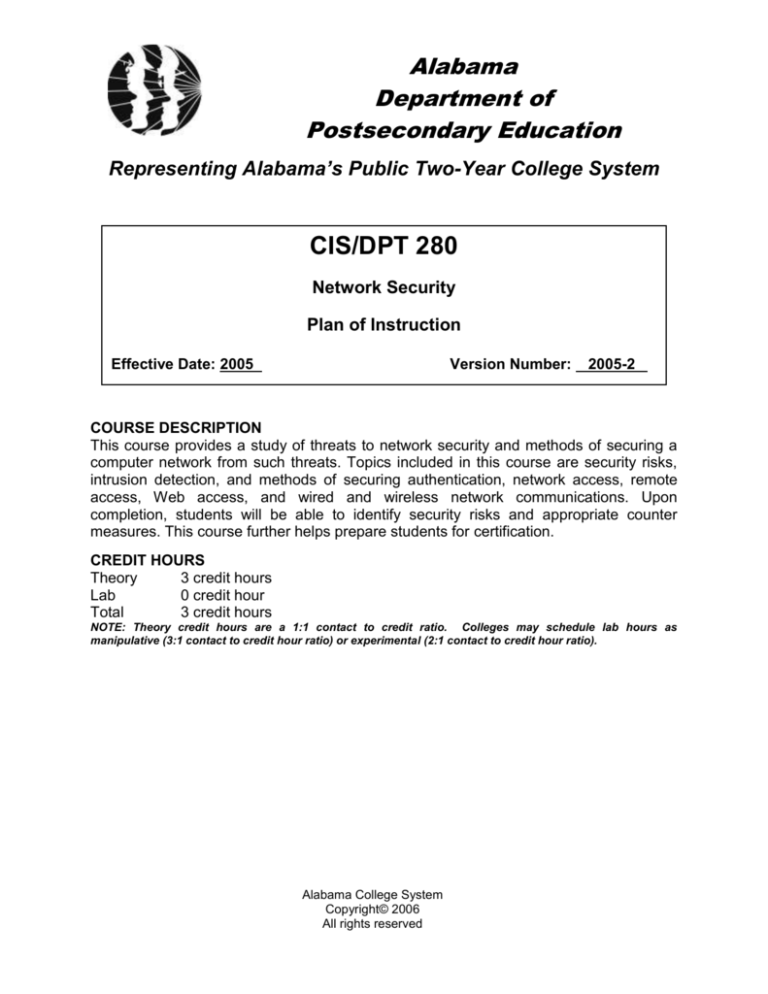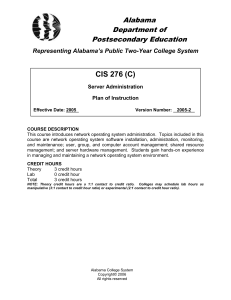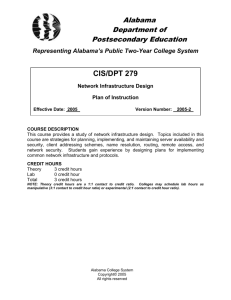
Alabama
Department of
Postsecondary Education
Representing Alabama’s Public Two-Year College System
CIS/DPT 280
Network Security
Plan of Instruction
Effective Date: 2005
Version Number:
2005-2
COURSE DESCRIPTION
This course provides a study of threats to network security and methods of securing a
computer network from such threats. Topics included in this course are security risks,
intrusion detection, and methods of securing authentication, network access, remote
access, Web access, and wired and wireless network communications. Upon
completion, students will be able to identify security risks and appropriate counter
measures. This course further helps prepare students for certification.
CREDIT HOURS
Theory
3 credit hours
Lab
0 credit hour
Total
3 credit hours
NOTE: Theory credit hours are a 1:1 contact to credit ratio. Colleges may schedule lab hours as
manipulative (3:1 contact to credit hour ratio) or experimental (2:1 contact to credit hour ratio).
Alabama College System
Copyright© 2006
All rights reserved
Network Security
CIS 280
PREREQUISITE COURSES
Determined by college unless stated otherwise
CO-REQUISITE COURSES
Determined by college unless stated otherwise
INSTRUCTIONAL NOTE: Students should posses a basic knowledge of concepts
related to computer networks.
PROFESSIONAL COMPETENCIES:
Identify threats to network security and detect intrusion.
Identify methods of securing network authentication, network access, remote
access, and Web access.
Identify methods of securing network communications.
GENERAL INSTRUCTIONAL OBJECTIVES:
The cognitive objective for this course is for each student to comprehend foundational
knowledge of network security risks and methods of securing a computer network.
There are no performance objectives directly associated with this course.
There are no affective objectives directly associated with this course.
PROFESSIONAL COMPETENCIES/OBJECTIVES:
Unless otherwise indicated, evaluation of student’s attainment of objectives is based on
knowledge gained from this course. During performance evaluations, students will be
provided necessary tools, equipment, materials, specifications, and any other resources
necessary to accomplish the task. Specifications may be in the form of, but not limited
to, manufacturer’s specifications, technical orders, regulations, national and state
codes, certification agencies, locally developed lab assignments, or any combination of
specifications
ACS Copyright© 2006
All rights reserved
2
Network Security
CIS 280
MODULE A – NETWORK SECURITY RISKS
PROFESSIONAL COMPETENCIES
A1.0
Identify threats to network
security and detect intrusion. (B)
PERFORMANCE OBJECTIVES
A1.1 This module is measured cognitively.
ENABLING OBJECTIVES
A1.1.1
A1.1.2
A1.1.3
A1.1.4
A1.1.5
A1.1.6
Explain terms and concepts associated with network security.
Identify risks associated with authentication.
Identify risks associated with services, protocols, and the network
infrastructure.
Identify network intrusion methods.
Identify the risks associated with malicious code.
Explain the significance of auditing, logging, and system scanning.
KSA
Indicators
B
B
B
B
B
B
MODULE B – EXTERNAL NETWORK SECURITY
PROFESSIONAL COMPETENCIES
B1.0 Identify methods of securing
network authentication, network
access, remote access, and Web
access. (c)
B1.1
PERFORMANCE OBJECTIVES
Given a scenario and specifications, design
configurations to provide external network
security.
ENABLING OBJECTIVES
B1.1.1
B1.1.2
B1.1.3
B1.1.4
B1.1.5
Explain strategies for establishing secure authentication.
Describe firewall configuration.
Explain Public Key Infrastructure (PKI) technologies.
Explain various remote access technologies.
Explain various Internet security concepts and protocols.
KSA
Indicators
c
c
b
B
c
MODULE C – INTERNAL NETWORK SECURITY
PROFESSIONAL COMPETENCIES
C1.0
Identify methods of securing
network communications. (c)
PERFORMANCE OBJECTIVES
Given a scenario and specifications, design
configurations to provide external network
security.
KSA
ENABLING OBJECTIVES
Indicators
C1.1.1 Describe aspects of physical network infrastructure security.
B
C1.1.2 Describe establishing security policies.
c
C1.1.3 Describe uses of data encryption for storage and transmission.
B
C1.1.4 Describe methods of configuring a secure wireless network.
c
C1.1.5 Describe methods of securing files and folders.
c
C1.1.6 Describe the process of hardening applications and firmware.
c
C1.1.7 Describe methods of backing up systems.
c
ACS Copyright© 2006
All rights reserved
C1.1
3
Network Security
CIS 280
COURSE CONTENT OUTLINE
MODULE A – NETWORK SECURITY RISKS
Network security terms and concepts
Risks associated with authentication
Authentication protocols
Certificates
Usernames and Passwords
Biometrics
Risks associated with services, protocols, and the network infrastructure
Services
Protocols
Network infrastructure
Network intrusion methods
DOS / DDOS (Denial of Service / Distributed Denial of Service)
Back Door
Spoofing
Man in the Middle
Replay
TCP/IP Hijacking
Weak Keys
Mathematical
Social Engineering
Password Guessing
Brute Force
Dictionary
Software Exploitation
Risks associated with malicious code
Viruses
Trojan Horses
Logic Bombs
Worms
Auditing, logging, and system scanning
ACS Copyright© 2006
All rights reserved
4
Network Security
CIS 280
MODULE B – EXTERNAL NETWORK SECURITY
Securing authentication
Firewalls
Public Key Infrastructure (PKI)
Certificate authority
Digital certificates
Remote access technologies
Virtual private networks (VPN)
RADIUS (Remote Authentication Dial-In User Service)
IPSEC (Internet Protocol Security)
L2TP
PPTP
Internet security concepts and protocols
Secure Sockets Layer (SSL)
Hypertext Transfer Protocol Over Secure Sockets Layer (HTTPS)
Pretty Good Privacy (PGP)
Secure Multipurpose Internet Mail Extension (S/MIME)
MODULE C – INTERNAL NETWORK SECURITY
Physical network infrastructure security
Establishing security policies
Data encryption
Securing wireless communication
File and folder level security
Sharing
File system security
Hardening
Updates
o Hotfixes
o Service Packs
o Patches
o Firmware
Securing servers
Securing clients
System backup
ACS Copyright© 2006
All rights reserved
5
Network Security
CIS 280
RECOMMENDED METHODS OF EVALUATION: The tables of specifications below identify the
number of cognitive (knowledge) enabling objectives, psychomotor (performance) objectives,
and affective (attitudinal) objectives per module. Instructors should develop sufficient
numbers of evaluation items to ensure complete coverage of each cognitive and/or
psychomotor objective identified in each module. For cognitive objectives, use appropriate
written test type based on the complexity indicator for each objective. Create comprehensive,
checklist evaluations for each psychomotor objective.
Facts/Nomenclature (A/a): Multiple Choice, Fill-in, List, Matching, Alternative Response
(true/false or yes/no)
Principles/Procedures (B/b): Multiple Choice, Fill-in, List, Short Answer
Analysis/Operating Principles (C/c): Multiple Choice, Short Answer, Essay
Evaluation/Complete Theory (D/d): Multiple Choice, Short Answer, Essay
ENABLING OBJECTIVES TABLE OF SPECIFICATIONS
Cognitive Domain
Facts/
Nomenclature
Principles/
Procedures
-
6
2
2
Module A
Module B
Module C
Analysis/
Operating
Principles
3
5
Evaluation/
Complete
Theory
-
Total
6
5
7
Total
PERFORMANCE OBJECTIVES TABLE OF SPECIFICATIONS
Psychomotor Domain
Limited Proficiency
Partially
Proficient
Proficient
Highly
Proficient
Total
0
0
0
0
0
0
0
0
Module A
Module B
Module C
Total
AFFECTIVE OBJECTIVES TABLE OF SPECIFICATIONS
Affective Domain
Receiving
Responding
Valuing
Organization
Characterization
by Value
Total
0
0
0
0
0
0
0
0
0
Module A
Module B
Module C
Total
ACS Copyright© 2006
All rights reserved
6
Network Security
CIS 280
Knowledge, Skills, and Attitudes (KSA) Indicators
Key Word(s)
Definition
Highly
Performs competency quickly and accurately. Instructs others how to do
Proficient
the competency.
Performs all parts of the competency. Needs only a spot check of
Proficient
completed work.
Partially
Performs most parts of the competency. Needs help only on hardest parts.
Proficient
Performs simple parts of the competency. Needs to be told or shown how
Limited Proficiency
to do most of the competency.
Complete
Predicts, isolates, and resolves problems about the competency.
Theory
Operating
Identifies why and when the competency must be done and why each step
Principles
is needed.
Procedures
Determines step-by-step procedures for doing the competency.
Nomenclature
Names parts, tools, and simple facts about the competency.
Evaluation
Evaluates conditions and makes proper decisions about the subject.
Analysis
Analyzes facts and principles and draws conclusions about the subject.
Identifies relationship of basic facts and states general principles about the
Principles
subject.
Value
Performance
Ability
4
3
2
Affective
Knowledge
Knowledge of
Skills
1
d
c
b
a
D
C
B
A
Facts
*5
Characterization by
Value
*4
Organization
*3
Valuing
*2
Responding
*1
Receiving
Identifies basic facts and terms about the subject.
Acting consistently with the new value
Integrating a new value into one's general set of values, giving it some
ranking among one's general priorities
Showing some definite involvement or commitment
Showing some new behaviors as a result of experience
Being aware of or attending to something in the environment
Alpha Scale Values - Any item with an upper case letter (A, B, C, D) by itself is taught as general information on a topic. This information may be related to the
competency or encompass multiple competencies. Examples might include mathematical computations or knowledge of principles such as Ohm’s Law.
A lower case letter indicates a level of ”Knowledge of Skills." Individuals are taught information pertaining to performing a competency . These may be indicated
alone or in conjunction with a numerical scale value. A lower case letter by itself indicates the individual is not required to perform the task-just know about the task.
(example: Can state or explain procedures for doing a task).
Numerical Scale Values - The numbers reflect the levels the individual will be able to perform a competency. Number values are always accompanied by lower
case letters (i.e. 1a, 2b, 3c...etc.) in order to specify the level of knowledge of skills associated with the competency.
Example: An individual with a competency with a scale indicator of 3b has received training of knowledge of skills whereby he or she can determine the correct
procedures and perform with limited supervision; only requiring evaluation of the finished product or procedure.
Asterisk items indicate desired affective domain levels and are used to indicate the desired level for a given competency. They may be used independently or with
other indicators (i.e. 1a-*1, 2c-*3). If used with another indicator, separate with a hyphen.
NOTE: Codes indicate terminal values.
ACS Copyright© 2006
All rights reserved
7










